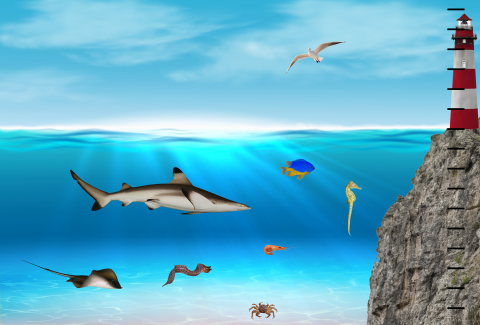Sea level
What numbers would you put on this number line as it goes under the sea level?
Problem
What can you see in this picture? You can click on it to make it bigger if you would like a closer look.
We will call sea level '0' and then we could think of the lines as representing positive numbers going upwards and negative numbers going down to the sea bed.
In this task, we are going to look at where the mouths of each of the different animals are. This will allow us to see how deep they are compared to each other, or what distance apart they are.
For example, the seahorse's mouth is 1 metre deeper than the mouth of the blue and yellow fish.
Have a think about these questions, or you might like to make up some of your own:
- What number should be where the head of the seagull is?
- What number should be where the mouth of the crab is?
- How far up is it from the head of the shrimp to the mouth of the shark?
- How far from the surface is the eel's mouth?
- How high above the sea level is the seagull's beak?
- How much higher is the seagull's beak than the seahorse's mouth?
How did you arrive at your answers? Did you write anything down to help you?
Getting Started
How about using the lighthouse like a number line?
Try counting the markings, one by one.
Perhaps you can do a calculation in your head rather than counting? How?
Student Solutions
Thank you to everybody who sent in their ideas about this task. Adam, Appin, Maya, Sol and Suria from Parklands School, Albany, Australia sent in this solution:
We wrote the numbers from the question on the metre line marks to make it easier to see and remember. We also used a ruler to align the mouths of the animals with the closest marking. We were then able to count the difference using the marks like a number line. We found these answers:
1. The seagull is 4m above sea level
2. The crab is 9m below sea level (or -9)
3. The shrimp is 2m lower than the shark
4. The eel is 7m below the surface (or -7m)
5. We thought this was the same as question 1, so it is 4m.
6. The seagull's beak is 7m higher than the seahorse's mouth.
This is very clearly explained. Take a look at Adam, Appin, Maya, Sol and Suria's full solution to see how they annotated the picture.
Myla and Farah from Maltman's Green School in the UK both drew bar charts to represent the distances of the different animals from the sea level. Have a look at Myla's bar chart. Can you see why Myla has used the calculation 4+3=7 to work out the answer to our sixth question?
We also received correct solutions from: Oisin from Ballyhack National School in Wexford, Ireland; Rayya from British School Al Khubairat in the UAE; Ahmed and Dhruv; Hannah from Burley and Woodhead C of E Primary in the UK; Astrid from High March School in the UK; Toby and Elsie from Shirland Primary in the UK; and Imeth, Aseel and Safura from Pristine Private School in the UAE. Thank you all for sharing your thoughts with us.
Some children suggested other questions that could be asked about this picture. Farah asked:
How far is the crab's head to the top of the lighthouse? 15m
Hannah asked:
How many metres is the very top of the lighthouse to the sting ray?
Astrid from High March School in the UK also came up with some questions of their own. Take a look at Astrid's full solution to see their questions.
Can you answer all of these questions?
Teachers' Resources
Why do this problem?
This problem is a good way to increase familiarity with negative numbers on a number line. In answering the questions, children begin to calculate with negative numbers in a context that will give them confidence rather one which they perceive as difficult.
Possible approach
It would be a good idea to print out the picture so that children can put on the numbers and more easily use a ruler to see which objects are at a certain level. To make the link with calculation more explicit, you could have a go at writing number sentences for some of the questions as a class, then challenge the children to complete number sentences for the other questions. Pupils can then go on to invent questions of their own and, in particular, they could find alternative ways of asking the same question. For example:
Key questions
Tell me about the depth of these fish.
Possible extension
You could invite children to make up as many questions as they can which have, for example, the answer $3$m. This allows them to be as creative as they like, and is a good way to assess their understanding.
Possible support
Some children will benefit from having a go at the Swimming Pool problem before this one.


